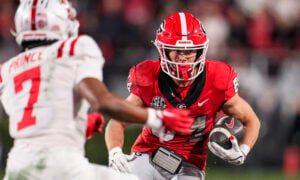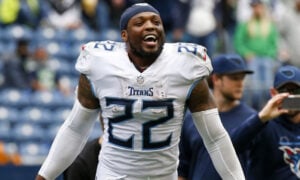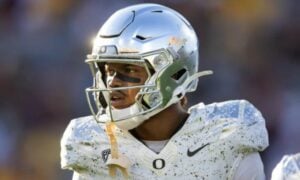Rookie Pre-Draft Top 20
We’re closing in on the unofficial kick-off date of the new 2016 season, the NFL Draft.
I’m sure I can speak for many of you in that the draft is always one of the most exciting times of the year. Not only does my primary league start its draft when the first team is on the clock, but we all get to play along as this year’s new rookies find their way to the NFL and potential stardom.
That all said, I’m not excited about the prospects of the 2016 rookie class. That’s not to say that we won’t have major eventual fantasy producers from this class, but if you are looking to take competitive steps from this draft, the odds are stacked against you.
There’s a reason that I’ve jettisoned 2016 first round picks at every opportunity. Obviously I haven’t been trading them away without return value, but you understand my point here I’m sure. I’d much rather sell on a high degree of unknown than buy into it.
At the very top, we do have three players that I believe present significant upside and potential, but only my first ranked player carries a level of guarantee that I’m comfortable with. Truth be told, we know that very few rookies should ever have a “guarantee” tags attached, but that doesn’t stop us from applying them. For Ezekiel Elliot, it’s as good as it gets this year. Following him, the odds drop significantly.
This is a draft light on tangibles that suggest great things in the NFL. From this class we’re certain to get players from later rounds that become fantasy performers – and that is where the intrigue exists for me. This is a fantastic draft to stock up on second and third year picks if you have the roster space available. Don’t get carried away because we’re talking about a 15-20% chance of any fantasy production, but the pool of players able to deliver that will be more intriguing when we get to pick 15 or so this year.
I’ll be following this piece up with a “Third Round Magic” article where I focus on those players outside the top 20 that I feel have significant value upside. I’ve always done some of my best fantasy draft work in the third round of rookie drafts.
But, back on topic here, let’s get to my initial pre-draft top 20 list:
[am4show have=’g1;’ guest_error=’sub_message’ user_error=’sub_message’ ]
1. Ezekiel Elliott, RB
Elliott is now the easy choice as the first selection in this year’s draft class. Once second on my list, after further film study on my top three candidates, Elliott rose to the top without question.
He truly is a well-rounded back that can immediately contribute in all phases of the game immediately as a rookie. He’s quite accomplished in pass protection as well, meaning that he can see three-down work in year-one. His size and athleticism make him as solid, high-value, very-low-risk, target in fantasy drafts.
Even if your team needs a receiver, this year I believe you have to select Elliott and either seek a trade or take another year to get to build at the position.
2. Laquon Treadwell, WR
Treadwell has held onto the 1.02 ranking on my pre-draft list by the slimmest of margins.
Running a 4.63 forty hurt his value immensely, but it was also fully expected. Funny thing about speed for receivers in that concerns ALWAYS carry far more weight shortly after the NFL Combine and tend to fade into the draft and beyond. I expect Treadwell to be no different. Don’t forget that DeAandre Hopkins ran a 4.57 and Larry Fitzgerald also ran a 4.63. Speed is not necessarily a determinant in production at the next level unless the player is remarkably slow.
Treadwell possesses the route chops, commanding size and ball skills to be a matchup nightmare on every play. He won’t get any faster nor does he need to, he wins consistently at the point of reception and long speed is not needed in many of the routes in the tree, especially those within the red zone.
3. Josh Doctson, WR
TCU receiver Doctson is my favorite player in the draft for a number of reasons. One of my favorite secondary traits to look for in impact receivers for the next level is fluidity on the run, out of breaks and to the ball. Doctson is just that in all phases of his game, fluid. He’s extremely quiet off the line of scrimmage, in his stems and his hips provide for clean breaks and dips.
With the ball in the air, Doctson is fantastic at using leverage to gain separation and advantage toward climbing the ladder (41” vertical) to the reception. His hands are as fluid as his body and he’s naturally gifted at extending and snatching with proper hand (dominant) switching as necessary to his left or right, high or low.
He could easily be the receiver to end up as the most productive in the NFL from this draft class ten years from now. I’d like to see him add 10-15 pounds at the next level as long as it doesn’t affect his speed/fluidity dynamic.
4. Corey Coleman, WR
For me, this is where things get dicey and I have little desire to be out of the top three in this draft. If holding the 1.04, I’d do everything I can to move up or out altogether, likely seeking a trade for a known commodity.
If you have to select, Coleman is an intriguing 1.04 selection. He’s a gritty player that plays with a chip on his shoulder and larger than his 5’11” frame would suggest. He’s got lightning quick feet and the ability to separate which should transfer to the next level. His 4.37 forty time will delivery productivity if he’s able to get over the top of defenses in the NFL.
The risk with Coleman is that he’s a bit of a tweener as he he’s best outside the numbers but likely won’t make his living there in the NFL. He’ll need to adapt his game to play between the numbers in all likelihood. Either way, he has the speed/agility dynamic to be a difference-maker in his first year.
5’11” receivers will always carry significant risk as they step up to the next level.
5. Derrick Henry, RB
Many are applying the Brandon Jacobs comparison to Henry and while that tag can apply due to his size, I believe it does sell Henry’s upside short. Jacobs was never a high-ceiling prospect. I hesitate to consider Henry a “high-ceiling” player as I don’t believe he can truly transcend his size, but he’s more capable than being given credit for.
Henry’s real value will be in non-PPR leagues where he could well be a touchdown machine. But in any format, Henry does have value and upside. While he’s a downhill runner, he does have the ability to run stretch plays in the NFL and utilize his vision to square his shoulders and exploit seams and creases, using his strength and power to gain yardage, especially after contact.
Don’t sell Henry short, I believe his upside is well beyond that of Brandon Jacobs and, if the stars align, there’s an Eddie George ceiling possibility. That said, he has had an alarming number of carries (400+) which will concern many, including myself.
6. Kenneth Dixon, RB
Possessing ideal height and weight for the position, Dixon had been flying below the radar until just recently.
His lateral agility and jump cuts are plus-level and he brings a level of power to finish every run. Tape shows that he thrives after first contact, a must-have trait at the next level and one that scouts have near the top of their list for backs. He accelerates to reach top speed quickly after his first cut and while his 4.58 forty won’t impress, he plays faster than this timed speed.
A big negative is ball security as he did fumble 13 times over three seasons at Louisiana Tech. System will be a key indicator of early-career productivity but he has all the raw tools to be a bargain selection in fantasy if he falls late into the first round.
7. Michael Thomas, WR
Thomas is a pure feast or famine prospect at the next level and fantasy is onto him.
In “feast” mode (I like that), Thomas’ intriguing size and play dynamic combine to make for an extremely high ceiling. He looks the part off the line of scrimmage and has the length to cause problems over the top or on slants and outs. In “famine” mode, Thomas’ raw skill set won’t be developed due to not being elite in any one area and lacking suddenness in his routes. Which mode will win out?
Thomas has all the tools in the belt to get the job done but may not know how to put it all together. With the right receivers’ coach, he could very well develop but well rounded and capable receivers lacking an elite trait often remain mediocre or upside-only talents, never realizing the “up”.
8. Leonte Carroo, WR
I’m one of those that have been singing the praises of Leonte Carroo as an upside player in this draft.
Character flag (assault) aside, which are always tough to dismiss, Carroo is a receiver that plays above his 6’ height. He’s not elite in any one area but is accomplished and a performer in most. Carroo is one of those players who transcends his Combine performance and needs to be viewed on tape during games to show ability and productivity.
The Rutgers system will not translate to the NFL so collegiate productivity must be evaluated more based on skill-set than numbers alone. His route running is a bit raw and he tends to lose leverage and separation due to footwork and lost acceleration as he lifts into or out of his breaks. Doesn’t have the speed to make a living over the top but does excel with physicality and strength at the point of the reception.
Very tough to gauge his NFL career and he, like most other receivers in this draft, will be in “show-me mode” before carrying any great value.
9. Tyler Boyd, WR
Out of Pittsburgh, Boyd has seen his stock rise and then fall following the Combine.
Boyd possesses good size but need weight and strength at the next level to go with his relatively savvy route intelligence and physicality. He plays stronger than his weight would suggest and he has a chip on his shoulder on and off the field. The internal fire of Boyd is what I like most about him, he has a little “it” factor that I absolutely need in my receivers.
Boyd also has vice-grip hands and the ability to win the reception at multiple levels. He’s not an elite leaper and his pro-day forty of 4.50 is only adequate. Another player who shows far better on tape than at the combine. He’s a prospect who could very well outplay his drafted position.
10. Sterling Shepard, WR
Shepard is riding a wave of positivity and momentum following a nice Combine showing.
Very fluid athlete and great hands and perhaps the best route runner in the class. Very disciplined in his breaks and cuts so as not to tip off defenders as to what is coming. Extremely capable with seemingly the entire route tree and to both his left and right. Plays at a good speed but not overly imposing.
Shepard is a high-quality, high-character receiver with the intelligence and route skill to be a great young player. He reminds me a bit of Torrey Smith although not as tall. Tough to project in the NFL or fantasy but I see his value squarely at the bottom of the first round in a ten team league, give or take two spots.
11. CJ Prosise, RB
I’m warming to him slowly as I watch more tape.
My first impressions when viewing Prosise was akin to my feelings while watching Bishop Sankey and I couldn’t get the comparison out of my head. Initially I hadn’t even put together that Prosise has great NFL size at 6’0” and 220 lbs. He plays far smaller, in agility and speed, than his size suggests he should.
His 4.48 speed is obvious as his on-ball and lateral agility. He’s got a ton of ability and could have three-down potential. That all said, he’s not very good in pass protection though has the size to adapt over time. His NFL start will likely be rather slow until he develops.
12. Devontae Booker, RB
As a 24 year old player in the NFL, fantasy will quickly move on, especially at the running back position. Running backs don’t have a long career as is and starting a year or two late on your NFL career isn’t going to bring a lot of excitement to a fantasy coach.
Drafted situation will be key for Booker as early work in the NFL that hastens his productivity will be needed for fantasy coaches to step up with an earlier-than-suggested selection. He possesses the size and shows enough speed and footwork to be an every down back at the next level. He lacks long speed but is capable enough in and through the line of scrimmage to be valuable.
13. Will Fuller, WR
Fuller is a wild card of massive proportion for me until I see his drafted situation.
Fuller worked out of a spread offense which can skew college vs. pro projections. His thin frame concerns me but he’s ultra-quick, can stick his foot in the ground to get flat quickly and has acceleration and speed to make defenders with a cushion pay. Small hands but snatches well. His 4.32 forty will raise his stock immensely.
Players like Fuller must find a system and quarterback that can get them into space which could provide upside of DeSean Jackson, Julian Edelman or Julian Edelman.
14. Jonathan Williams, RB
One of these next two backs is going to outplay his selection in fantasy and become an every-down back in the NFL and have a nice career. That is my own crystal ball that I’m looking into.
4.59 speed was a little surprising as I expected him to be closer to 4.50, but his play on the field and on tape is quicker. Sufficient hip swivel for his size, a chief trait that I target in my backs. Uses dips and fakes effectively and has the strength to drive through arm tackles. He has the look of an NFL back and plays like one as well.
If I had to choose, Williams would be my choice over my next player …
15. Jordan Howard, RB
Lacks the dynamic of Williams above. A productive churner of a back, Howard has the strength and one-cut ability to get up the field quickly.
Doesn’t possess the hips or elusivity that does Williams. Has a good leg drive and can win at the point of contact. Tends to get rather upright and runs a bit off-balance at times. Is the type of back that can have a better pro career than collegiate.
16. Rashard Higgins, WR
He’s 6’1”, 6’4” with the high-top and he plays like a 6’4” receiver. Was hoping to see a forty in the lower 4.5s but expected 4.58. He delivered a 4.60 which is good enough.
If you like upside in a raw package, Higgins is your player in the second round for value. He runs a good route tree, plays larger than his 6’1” height and has very capable hands. His measured vertical was surprisingly poor at 32”, I expected much closer to 40” which says something about what I saw on tape.
Has a dynamic on the field that I like with the “it” factor that I need to see to move up my board. He’s elite at extending for the catch and snatching before turning his shoulders up-field. Concerned about his frame and needs to add weight/mass. Can he be as good as he believes he is in the pros? He’s got a shot.
17. Alex Collins, RB
Collins remains one of my favorite backs in the draft but suffered a terrible Combine performance and has dropped in value significantly.
He’s got ideal NFL running back size and uses it well through the line of scrimmage and into first contact. Utilizes great patience while waiting for seams and creases to develop. Runs with toughness and power when needed but able to dip away as well. Plus-level lateral agility and hips though most don’t recognize this.
Collins is the perfect candidate when discussing those that rank rookies without watching film, blindly parroting what others say. Collins reminds me a lot of Marshawn Lynch as he exited from Cal. He’s not a fluid runner but more jerky, just like Lynch … and his style is extremely similar to Beast Mode. In the right system, he’ll have tremendous upside.
18. Jared Goff, QB
I’m a big fan of taking second round fantasy quarterbacks and Goff is a great selection if you can get him anywhere in the mid-second round.
He’s got everything needed to be a good college quarterback and I expect he’ll be the first player selected, as he should be. He’ll need to add weight in the pros but this shouldn’t be an issue. My only concern about Goff is his personality and level of humility which will be needed as the top selected player going to a poor team.
19. Kenyan Drake, RB
He’s an elite athlete running somewhere between a 4.31 and a 4.45 forty.
He’s got better size than I expected at 6’1” and 210 lbs. with the ability to add weight. Ultra-agile player with elite elusivity and long speed and acceleration to make defenders taking poor angles pay. Quick to the hole and into space.
The big question is just how much of a role Drake can carve out for his drafted situation. 210 pounds is okay at 5’10” or or 5’11” but at 6’1” it makes for a very lean body, meaning that he likely won’t be used as a three-down back, instead being relegated to third-down or spread formation work. May even be best suited in the slot and in space.
20. Tajae Sharpe, WR
Good height for a prospect but very lean and needs to add weight. Extremely small (8.5”) hands but that hasn’t translated to poor hands in college.
He’s still young and may still add weight prior to getting to NFL. Savvy route runner and shows intelligence. Fair footwork and shows the ability to utilize space well but doesn’t show physicality at the point of reception or in setting up the reception in traffic. In the NFL, may get taken out of the play at the line of scrimmage unless he can learn to beat jams and press coverage.
Don’t look for Sharpe to produce early in the NFL but instead, as a receiver that seeks to build on youthful experience into his third year.
Summary
There you have it, my pre-draft list to take into the draft. I’ll be updating this list following the draft noting why player have moved up or down based on their drafted situation so … stay tuned!
Follow me on Twitter: @DLF_Jeff
[/am4show]
- Lineup Advice: Wrap-up, Thank You and Goodbye (TTFN) - January 1, 2024
- Lineup Advice: Week 17 – Championship Edition - December 26, 2023
- Lineup Advice: Week 16 – The “What is” Edition - December 19, 2023


































































